Planting guide for local pest control
Staff Reporters
22 January 2022, 2:45 AM
 Shingleback Wine vineyard manager Paul Mathews. Photo by Meaghan Coles.
Shingleback Wine vineyard manager Paul Mathews. Photo by Meaghan Coles.The Hills and Fleurieu Landscape Board has launched a guide for commercial growers, farmers and home gardeners on how to control common insect pests by increasing plant biodiversity.
Natural predators of vineyard insect pests – A guide to the natural enemies of grapevine pests in South Australia was formally launched at events in the Adelaide Hills and Langhorne Creek.
Developed in consultation with entomologists and viticulturists, the guide shows how planting key native species near crops and gardens can encourage predator insects that act as effective biological control agents.
Biological control of pest insects can help growers and gardeners reduce pesticide use and reap a range of benefits such as lower operating costs, better plant quality and a healthier environment.
Hills and Fleurieu Landscape Board Chair David Greenhough says the guide will help vineyard managers and other growers understand which insects are beneficial and how to encourage them.
“The Hills and Fleurieu is home to a number of viticultural regions widely recognised for the quality of their wines and the health and beauty of the environment.
“This guide shows how growers can work in partnership with the environment to encourage certain insects and spiders that will in-turn improve grape quality and quantity.
“It provides practical information that growers can easily apply. This includes why certain insects are useful and what they look like; what plants the insects need to thrive, and how to control key insect pests.
“This information will be useful for developing better pest management strategies and ultimately reduce the use of pesticides.”
By planting or enhancing areas of native vegetation with locally-adapted species, growers can attract and build up a range of natural predators, also known as beneficial arthropods, such as insects, spiders and mites.
These plantings provide other benefits too, improving health and amenity, and providing habitat for other species like insect-eating birds and micro-bats that also benefit agriculture and horticulture.
Shingleback Wine in Willunga is a successful demonstration of what can happen when the guide’s principles get put into practice.
With the support of Biodiversity McLaren Vale, Rotary SA, and the Hills and Fleurieu Landscape Board, Shingleback planted four hectares with over 70 insect-attracting native plant species next to its vines.
This ‘insectary’ is one of the region’s largest beneficial insect plantings, which is delivering economic, biodiversity and community benefits.
Vineyard manager Paul Mathews has seen the impact of the plantings in just a couple of years.
“We first planted in 2019 and now that patch is thriving. It’s full of all the good bugs we want and acting as a reservoir providing a constant flow of little predators into the adjacent vineyard.
“It’s just terrific to see how many of these beneficial insects are out there amongst the vines. We regularly see lacewings, spiders, predatory mites and the odd lady beetle larvae. And every one of those is doing work for us.
“When we avoid unnecessary spraying and allow nature to do the work, we know things are in balance, and that’s how we like it. In recent years, we have also reduced sulphur use to favour our beneficial insect populations and released a predatory ladybird beetle (Cryptolaemus) to tackle scale.”
Written by Dr Mary Retallack, of Retallack Viticulture, and produced as part of the Hills and Fleurieu Landscape Board’s Wildlife for Wine project, the guide can be downloaded here or collected in hard copy through their offices in Mount Barker and Willunga.
The board encourages growers and gardeners to get a copy and grow their own patch of bio-control habitat for beneficial insects.

Photo by Jeremy Gramp.
The publication was made possible through the support of Retallack Viticulture Pty Ltd, Wine Grape Council South Australia and the EcoVineyards project. Funding for the guide was provided by the Hills and Fleurieu Landscape Board through the landscape levy, with additional support from the Australian Government’s National Landcare Program.